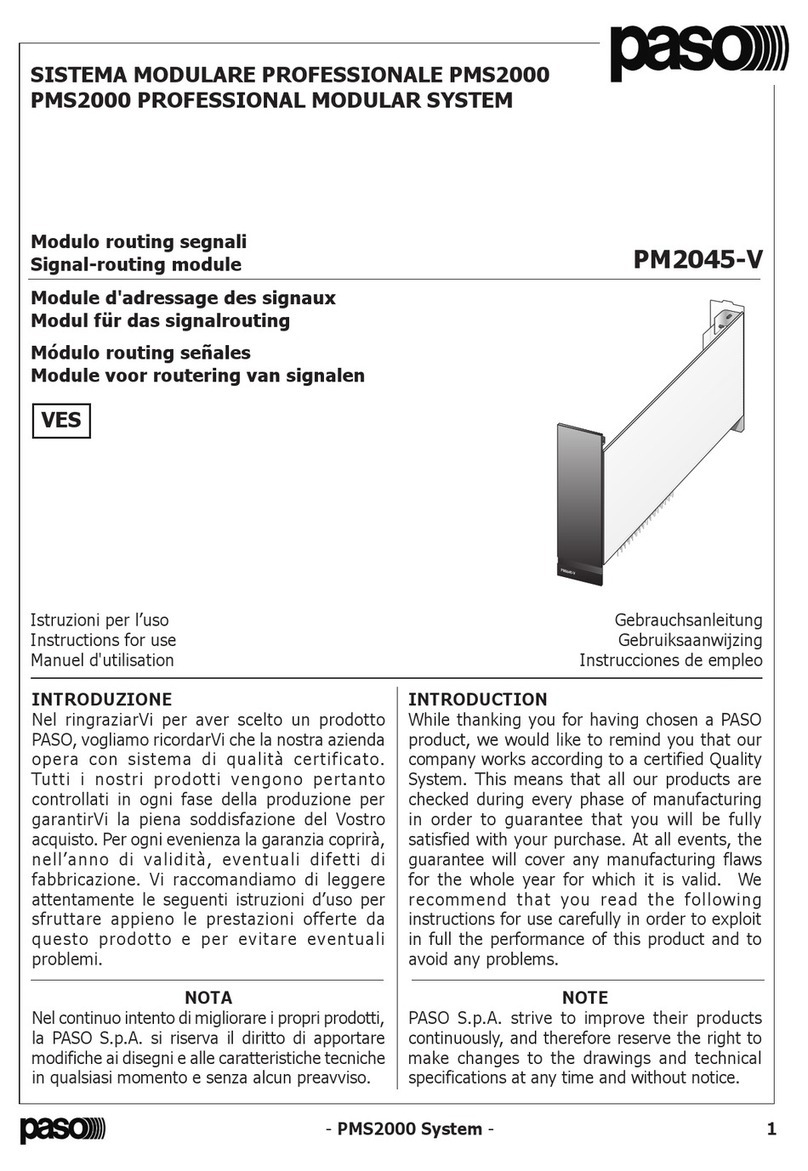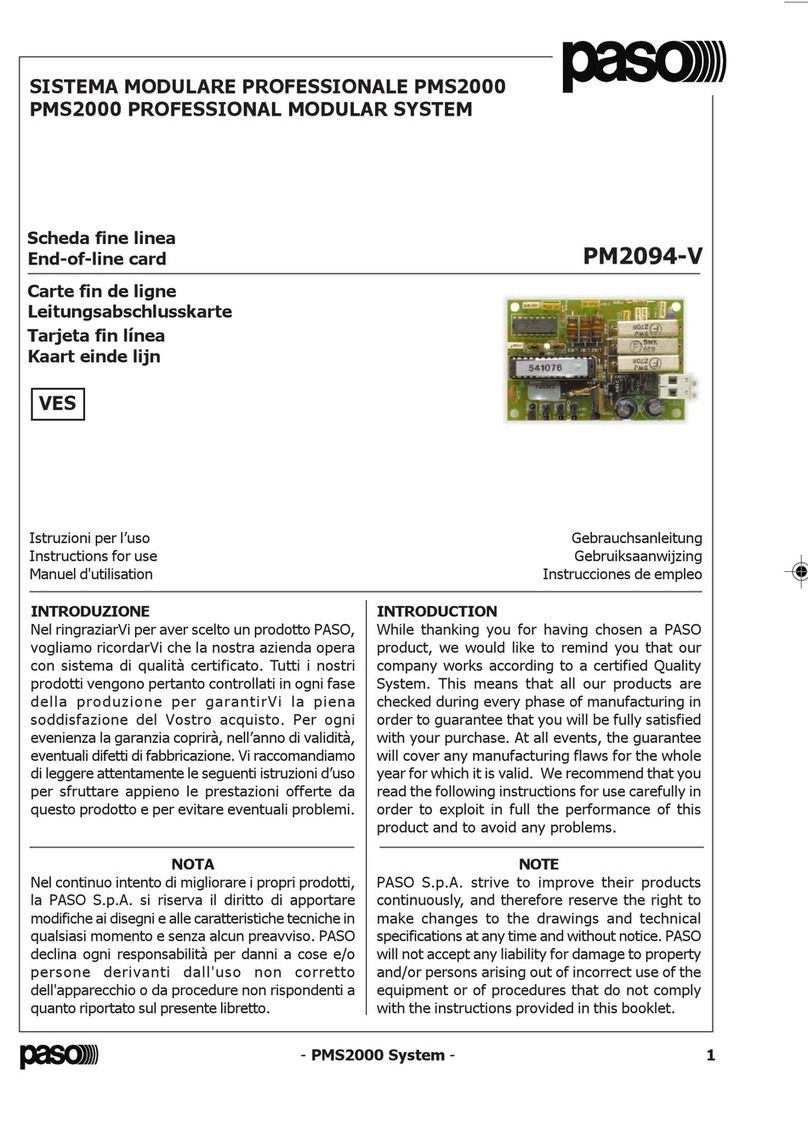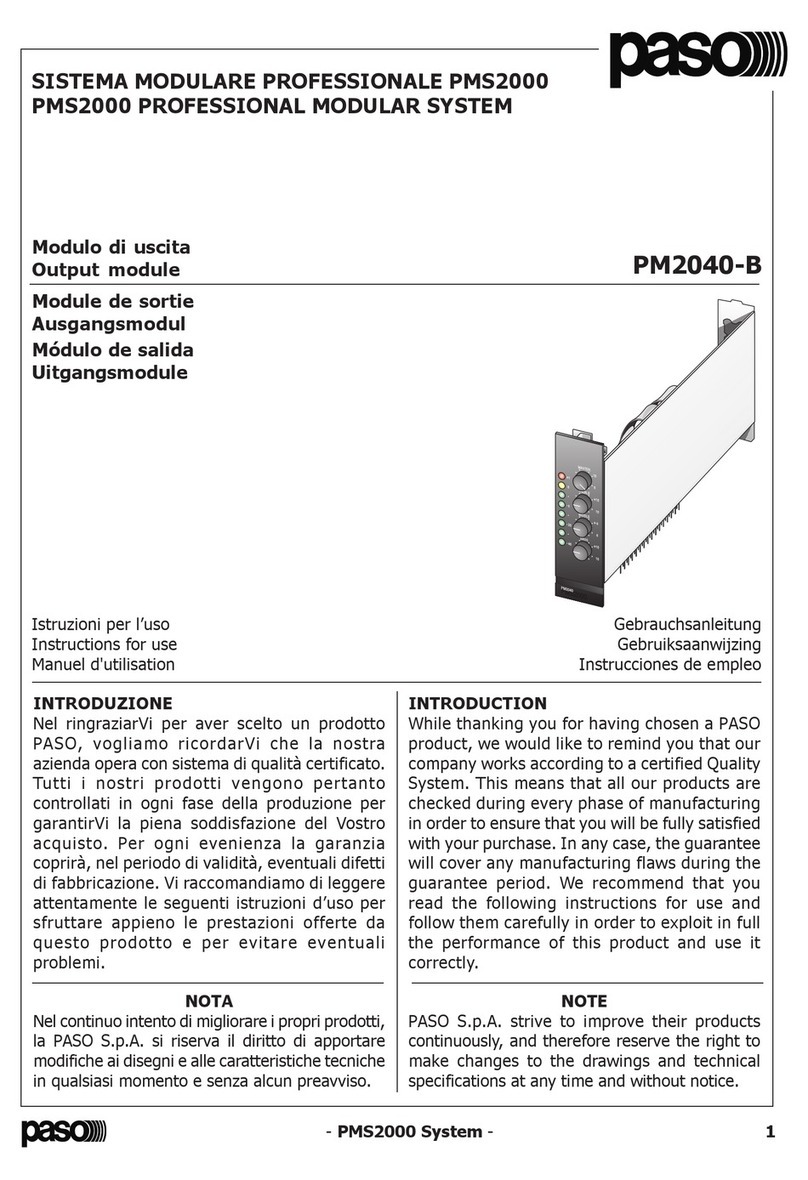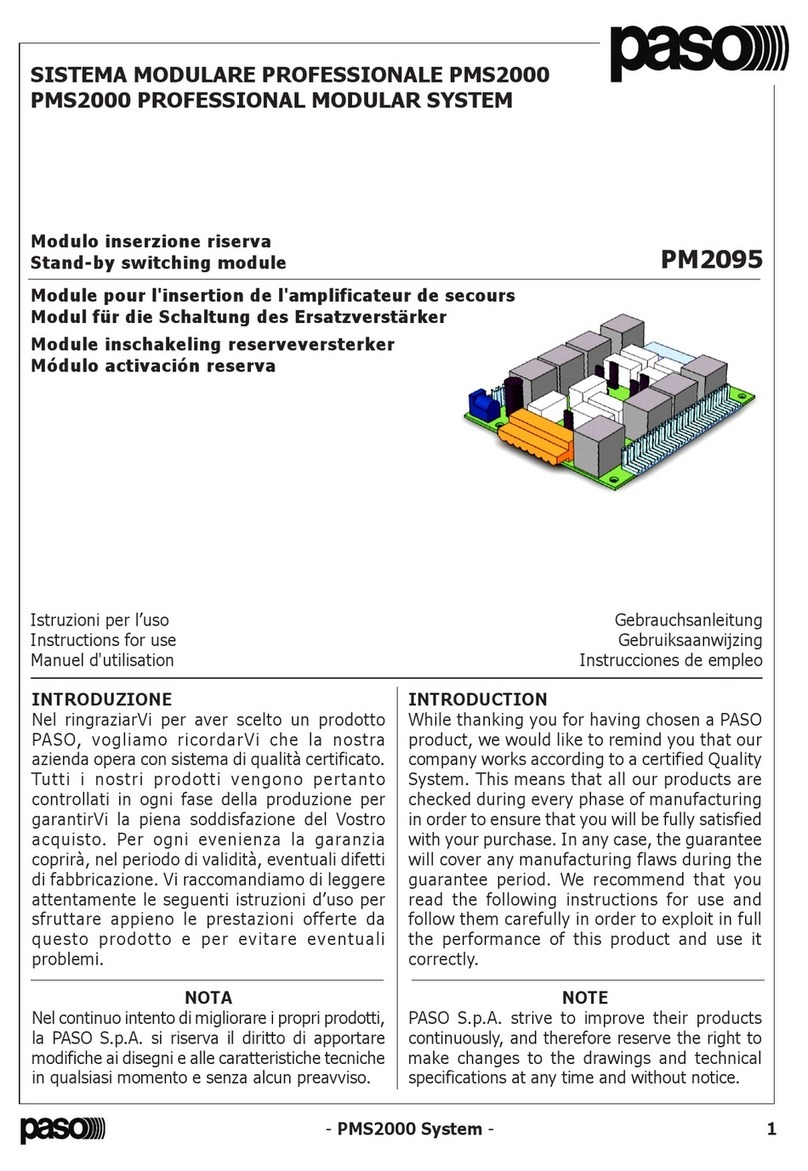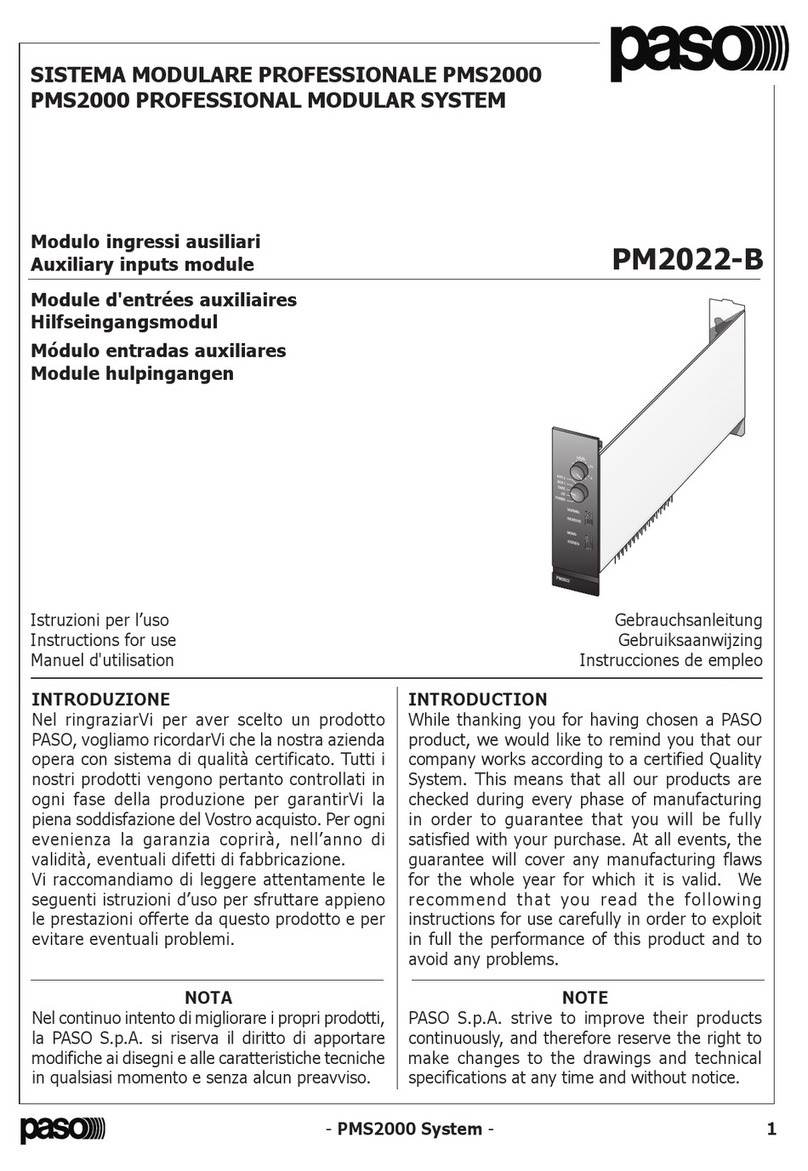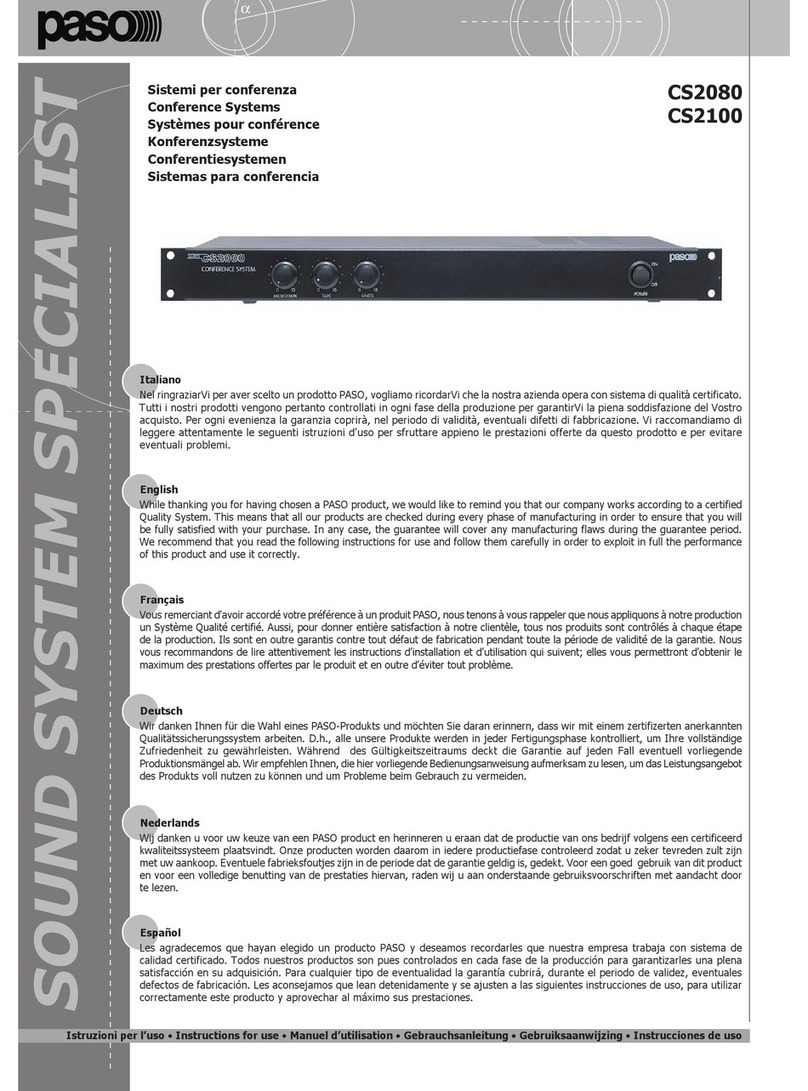
- PMS2000 System -
Ref. 11/519 PM2023-B
6
3.3 Assegnazione ai bus di miscelazione
Il segnale applicato all'ingresso, dopo essere stato
preamplificato ed equalizzato, viene inviato
(impostazione di default) su tutti i bus di
miscelazione (PA, destro e sinistro).
Per non assegnare al bus di miscelazione destro
il segnale relativo all'ingresso n° 1 occorrerà
rimuovere il ponticello dal connettore SW107 (per
l'ingresso n° 2 occorrerà rimuovere il ponticello
dal connettore SW108).
Per non assegnare al bus di miscelazione sinistro
il segnale relativo all'ingresso n° 1 occorrerà
rimuovere il ponticello dal connettore SW106 (per
l'ingresso n° 2 occorrerà rimuovere il ponticello
dal connettore SW109). Nel particolare caso che
non si desiderasse assegnare il segnale di uno, o
di entrambi gli ingressi, al bus di miscelazione PA
sarà possibile sfruttare i circuiti di gate operando
come segue: il circuito di gate corrispondente
all'ingresso che non deve essere assegnato al bus
PA dovrà essere abilitato e lasciato nella condizione
di "gate chiuso", i contatti della relativa morsettiera
del comando di precedenza, [7] e/o [9], dovranno,
cioè, rimanere aperti (vedi par. 3.7).
3.3 Assignments to the mixing buses
After being pre-amplified and equalised, the signal
applied to the input is sent (default setting) to all
the mixing buses (PA, right and left).
In order to avoid assigning the signal pertaining
to input n° 1 to the right-hand mixing bus, the
jumper should be removed from connector
SW107 (for input n° 2 the jumper should be
removed from connector SW108).
In order to avoid assigning the signal pertaining
to input n° 1 to the left-hand mixing bus the
jumper should be removed from connector
SW106 (for input n° 2 the jumper should be
removed from connector SW109).
In the specific case that you do not wish to assign
the signal of one of the inputs or the signals of
both of them to the PA mixing bus, it will be
possible to exploit the gate circuits proceeding as
follows: the gate circuit corresponding to the input
that must not be assigned to the PA bus must be
enabled and left in a "gate closed" condition.
That is to say that the contacts on the associated
precedence control terminal strip, [7] and/or [9],
must remain open (see point 3.7).
Per non incorrere in questa situazione è possibile
installare un'apposita scheda accessoria (vedi par.
4.2) in grado di adattare in modo automatico la
sensibilità d'ingresso al livello di uscita della
sorgente.
In order to avoid this situation, it is possible to
install a specific accessory card (see point 4.2)
that is capable of adapting the input sensitivity
automatically to the output level of the source.
3.4 Ammutolimento da linea di muting
Quando viene rilevata una condizione di priorità
attiva sull'apposita linea (quando viene, cioè,
rilevato un livello logico alto sul terminale
"MUTE IN" del connettore multivia) i segnali,
relativi ai due ingressi del modulo, applicati al bus
PA vengono ammutoliti (impostazione di default).
Per impedire che uno, o entrambi gli ingressi,
vengano ammutoliti, è necessario rimuovere i
ponticelli dai connettori corrispondenti: SW110
per l'ingresso n° 1 e SW111 per l'ingresso n° 2.
NOTA: la condizione rilevata sulla linea di muting
entrante (MUTE IN) viene riportata, in ogni caso
(indipendentemente, cioè, dalla presenza o meno
dei ponticelli SW110 e SW111), al terminale
"MUTE OUT" del connettore multivia ed inviata,
quindi, al modulo immediatamente successivo.
3.4 Muting via the muting line
When a priority condition is found to be active on
the line provided for this purpose (that is to say
when a high logic level is detected on the
"MUTE IN" terminal of the multi-way connector),
the signals relating to the two inputs of the module
applied to the PA bus are muted (default setting).
To prevent one or both inputs from being muted,
it is necessary to remove the jumpers from the
corresponding connectors: SW110 for input
n° 1 and SW111 for input n° 2.
NOTE: The condition detected on the incoming
muting line (MUTE IN) is sent, in any case (that
is to say regardless of the presence or otherwise
of the jumpers SW110 and SW111), to the
"MUTE OUT" terminal of the multi-way connector
and then sent on to the module immediately
following it.
- PMS2000 System -
Ref. 11/519 PM2023-B
43
módulos en el sistema: cada módulo de entrada
dispone de una prioridad superior con respecto a los
situados a su derecha (mirando frontalmente los
módulos), mientras que dispone de una prioridad
inferior con respecto a los instalados a su izquierda.
Las condiciones de precedencia son activadas por el
cierre de los contactos de las borneras [7] y [9].
Cerrando entre ellos los contactos de la bornera de
precedencia de una de las dos entradas ([7] ó [9])
de un módulo se realizarán las siguientes condiciones:
7.3.1 El bus PA será interrumpido y todas las
señales introducidas por los módulos
sucesivos (los situados a la derecha del
módulo considerado) serán enmudecidas.
Esta condición se realizará sólo si la
configuración correspondiente está
habilitada (ver párr. 2.5).
7.3.2 La línea de precedencia MUTE OUT será
activada; por consiguiente todos los
terminales MUTE IN de los módulos
sucesivos pasarán a un nivel lógico alto.
7.3.3 En los terminales BUSY ([8] y [10]) de
todos los módulos sucesivos será indicado
un nivel lógico alto; es decir que se indicará
una tensión positiva de 15 volt con respecto
al potencial común de masa de la
alimentación (blindajes de las tomas o
terminal correspondiente del módulo
alimentador).
NOTA: si se han cerrado los contactos de la bornera
relativa a la entrada n° 1 y se ha configurado la
condición de prioridad de entrada 1 sobre
entrada 2 (ver párr. 2.6) también el terminal
BUSY 2[10] de este módulo pasará a un nivel
lógico alto.
7.3.4 La línea de habilitación del generador de la
señal de preaviso (din-don) pasará a un nivel
lógico alto activando, por consiguiente, todos
los generadores instalados en el sistema.
NOTA: mientras esta línea se encuentra en el
estado alto (contactos de las borneras de
precedencia cerrados) es imposible activar
ulteriormente los generadores de señal que será
posible activar de nuevo sólo después de que la
línea haya vuelto al estado bajo.
7.3.5 El circuito de gate, entrada relativa a los
contactos utilizados para la activación de la
precedencia, será abierto, en el caso de que
esté habilitado (ver párr. 3.7 y Tabla de
configuración), y quedará tal mientras
dichos contactos queden cerrados.
door de positie van de verschillende modules in
het systeem: iedere ingangsmodule heeft een
hogere prioriteit dan de modules die zich aan de
rechterkant bevinden (wanneer men van voren
naar de modules kijkt. De voorrangscondities
worden geactiveerd door het aansluiten van de
kroonstenen [7] en [9]. Wanneer de kroonstenen
van één van de twee ingangen ([7] of [9]) van
een module op elkaar worden aangesloten, zal
zich het volgende voordoen:
7.3.1 De PA-bus zal onderbroken worden en alle
signalen die worden verzonden door de
volgende modules (de modules die zich
rechts van de module in kwestie bevinden)
zullen worden onderdrukt (muting). Dit zal
zich alleen voordoen indien de betreffende
instelling geactiveerd is (zie par. 2.5).
7.3.2 De voorrangsschakeling MUTE OUT zal
worden geactiveerd. Hierdoor worden alle
kroonstenen MUTE IN van de volgende
modules in een logische volgorde gerangschikt.
7.3.3 Op de kroonsteen BUSY ([8] en [10])
van alle volgende modules zal een hoog
logisch niveau worden doorgegeven;
dat wil zeggen, er zal een positieve
spanning van 15 volt ten opzichte van het
gemeenschappelijke massapotentiaal
van de voeding worden gegeven
(afschermingen van de aansluitingen of
speciale klem van de voedingsmodule).
OPMERKING: als de contacten van de
kroonsteen horend bij ingang 1 zijn gesloten en
de prioriteitskeuze ingang 1 voorrang op ingang 2
is ingesteld (zie par. 2.6), zal ook de kroonsteen
BUSY 2 [10] van deze module een 15 Volt
spanning weergeven.
7.3.4 De lijn voor activering van de generator
van het attentiesignaal (ding-dong) zal de
hoogste prioriteit krijgen.
OPMERKING: zolang deze lijn de hoge status
heeft (contacten van de precedence kroonstenen
gesloten) is het onmogelijk de signaalgeneratoren
nog verder te activeren. Deze kunnen pas worden
geactiveerd nadat de lijn is uitgeschakeld.
7.3.5 Het gate-circuit, van de ingang horend bij
de contacten die gebruikt zijn om de
voorrang te activeren, zal indien
geactiveerd geopend worden, (zie par. 3.7
en Configuratieschema), en zal zo blijven
zolang de contacten in kwestie gesloten
blijven.












